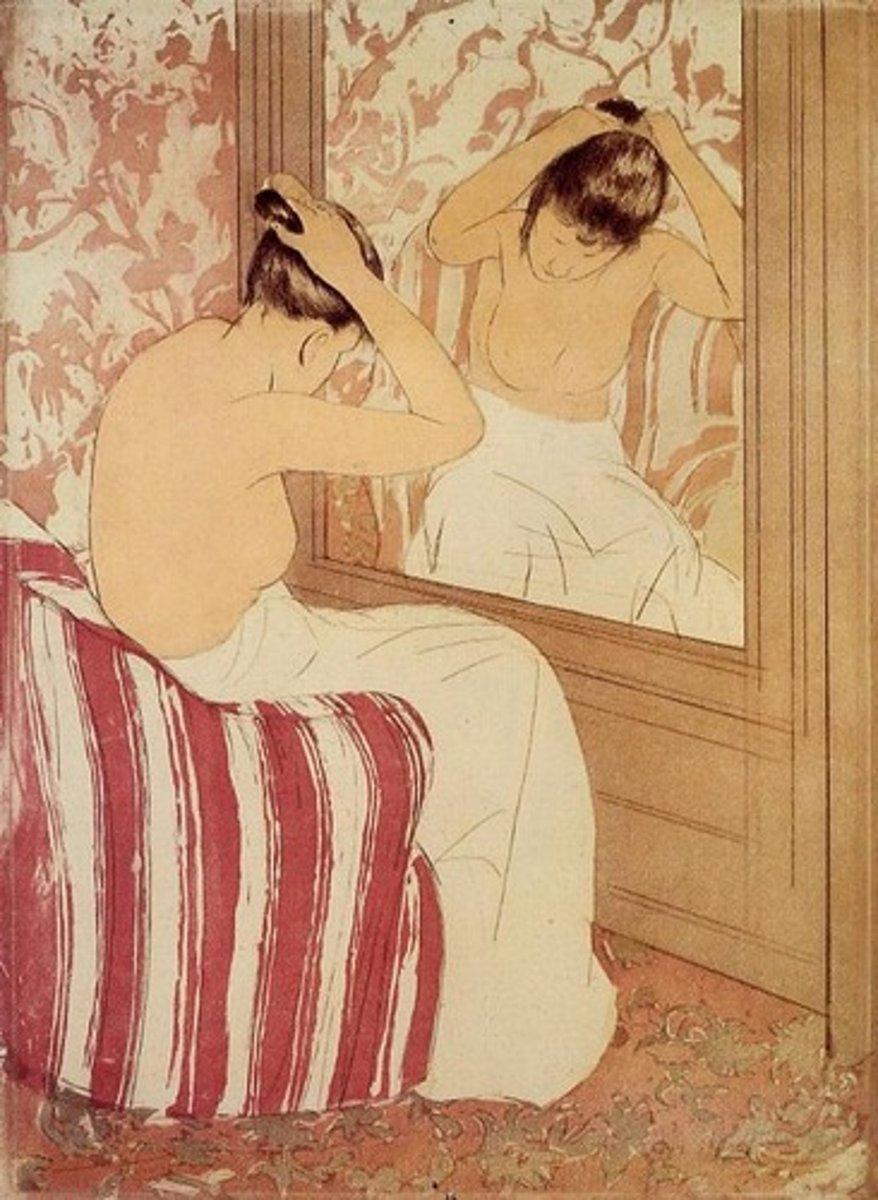AP Art History 250
1/31
There's no tags or description
Looks like no tags are added yet.
Name | Mastery | Learn | Test | Matching | Spaced |
|---|
No study sessions yet.
32 Terms
76. School of Athens
Form:
-fresco
-spatial illusionism
-fluid/interlocking
-same style as Sistine figures
-roundalls
-barrel vaults
-coffers
Content:
-branches of knowledge under faith
-philosophy and science
-Plate: idealism (points up)
-Aristole: realism (points down)
-Raphael self portrait
-Michaelangel on block of marble
-poetry, imagination
-disputah: faith and reason
-heavenly court of prophets and saints
-Jesus in full body halo
-Stanza della Segnatura: room of signatures
-acorns: symbol of family
Function:
-expresses knowledge and faith
Context:
-artist: Raphael
High Renaissance 1509-11 Vatican Palace under Pope Julius II
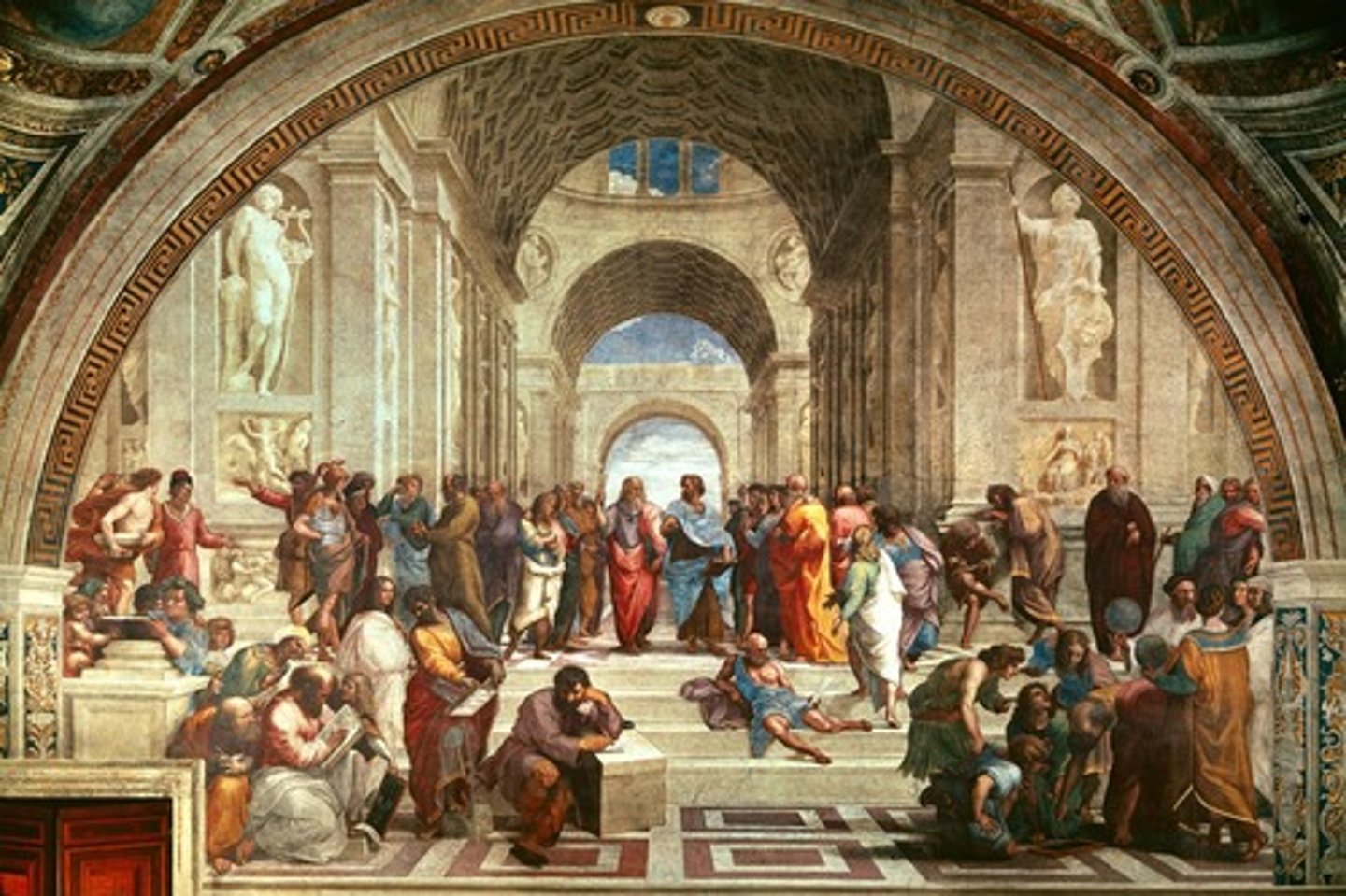
80. Venus of Urbino
Form:
-oil on canvas
-rich colors (red)
-nude reclining
-celebrating female body
-paints thin layer of paint to create flow and softness
Content:
-woman reclining while maids get her clothing
-dog=wealth
-seduction look= erotic
Function:
-wedding gift
Context:
-artist: Titian
-Ventian Renaissance 1538 CE

81. Frontispiece of the Codex Mendoza
Form:
-codex
-city laid out in 4 sections
-text
-ink and color on paper
Content:
-Part 1: creation of the City of Tenochtitlan (eagle on cactus describes how city was founded)
-Part 2: conquests achieved by Aztec alliances
-Part 3: daily life
-Templo Mayor
-canals dividing cities
Function:
-made for Spanish viceroy
-historical account for the Aztecs
Context:
-Aztecs 1541-42 CE
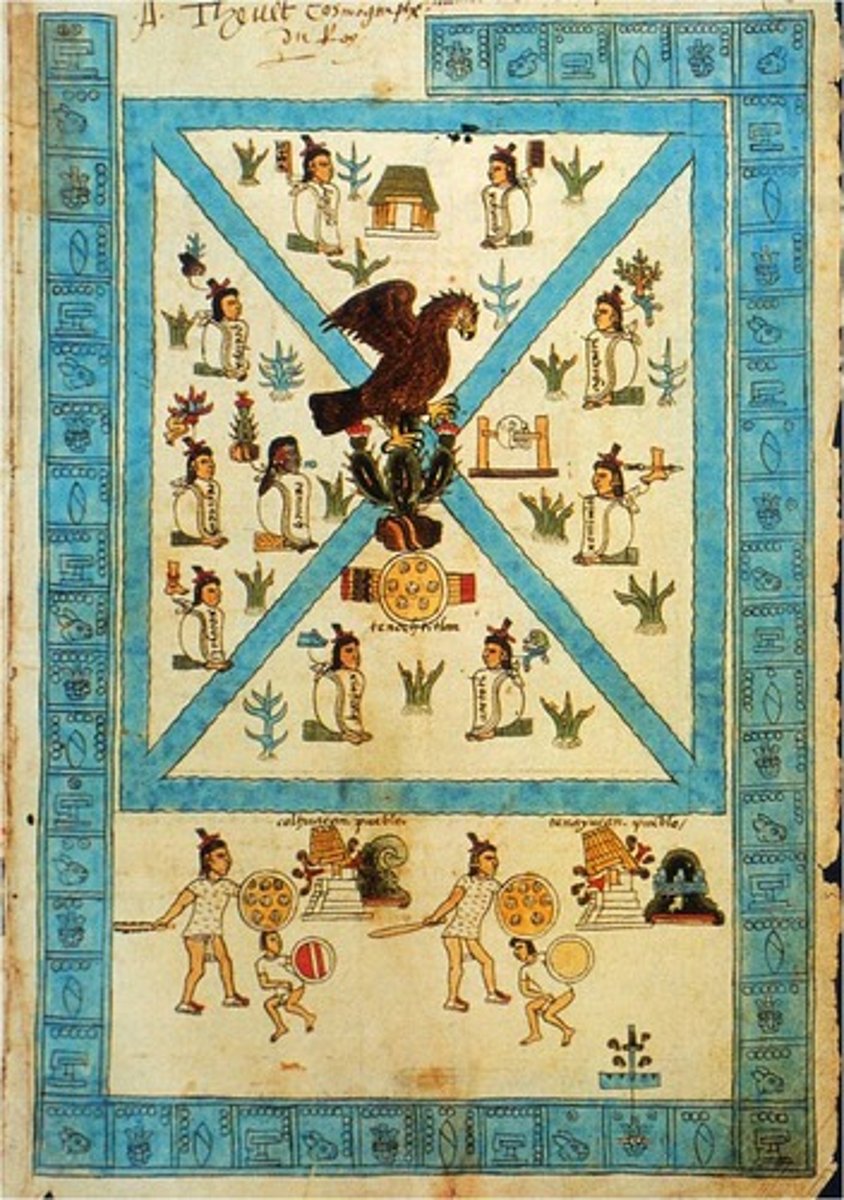
82. Church of Il Gesu
Form:
-building: marble, brick
-ceiling: fresco and stucco
-Lation cross plan, simple
-single aisle
-Post Reformation
Content:
-faith through the senses
-Last Judgement (ceiling) spatial illusionism, end of Baroque period
-IHS: interpretation of Jesus' name
Function:
-mother church for the Jesuits of the world
Context:
-architect: Giacomo da Vignola
-facade: Giacomo della Porta
-ceiling: Giovanni Battista Gaulli
-Jesuits are great defenders of the pope
-ceiling made 100 years later (1676)
-Rome, Italy
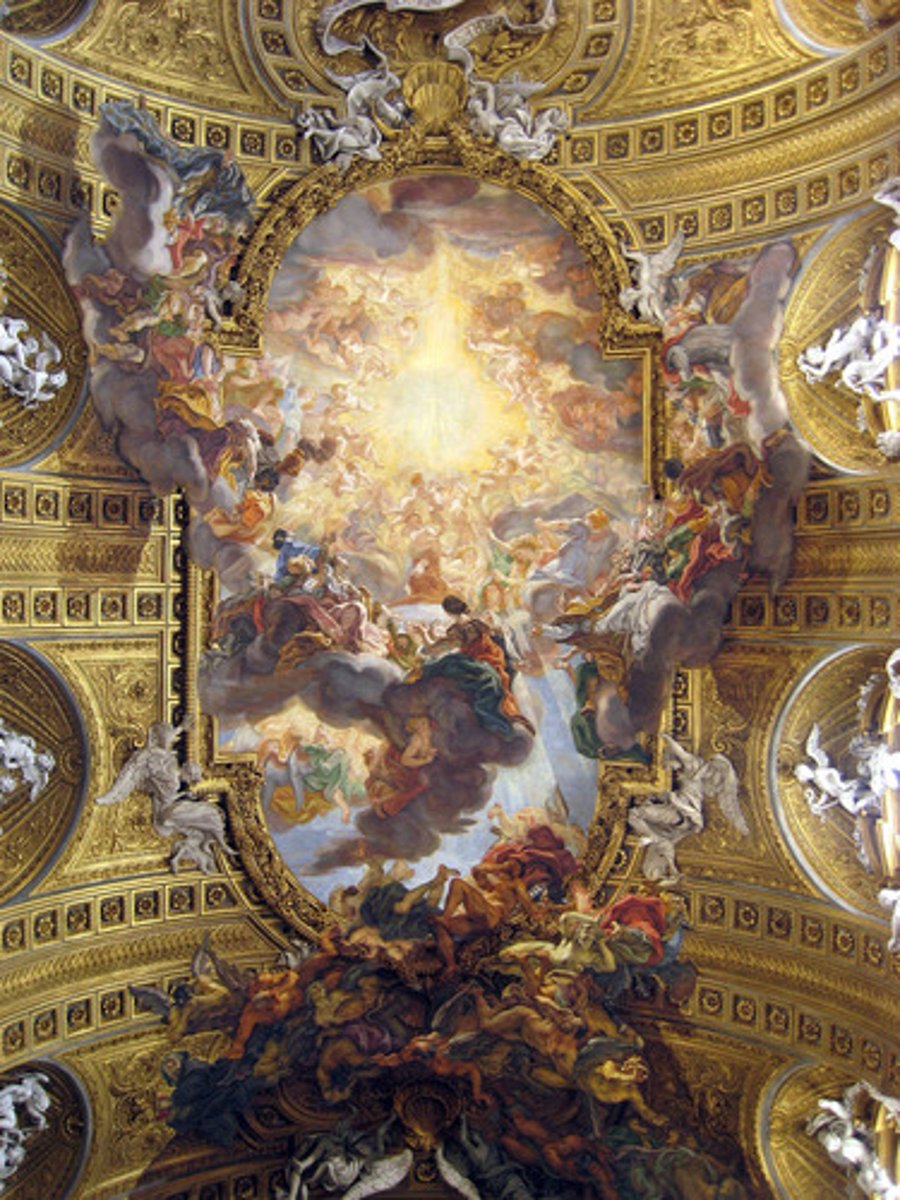
83. Hunters in the Snow
Form:
-endless, winter landscape
-panoramic view
-apart of series of 4 seasons
-oil on wood
Content:
-hunters coming back after an unsuccessful hunt (only one rabbit)
-people iceskating and curling (shows daily life)
-broken sign above inn
-vastness and beauty of world
Function:
-part of calendar series
0show how they had to get their food
0for dining room of wealth merchant in Antwerp
Context:
-artist: Peter Bruegel the Elder
1565 High Renaissance North
-Antwerp
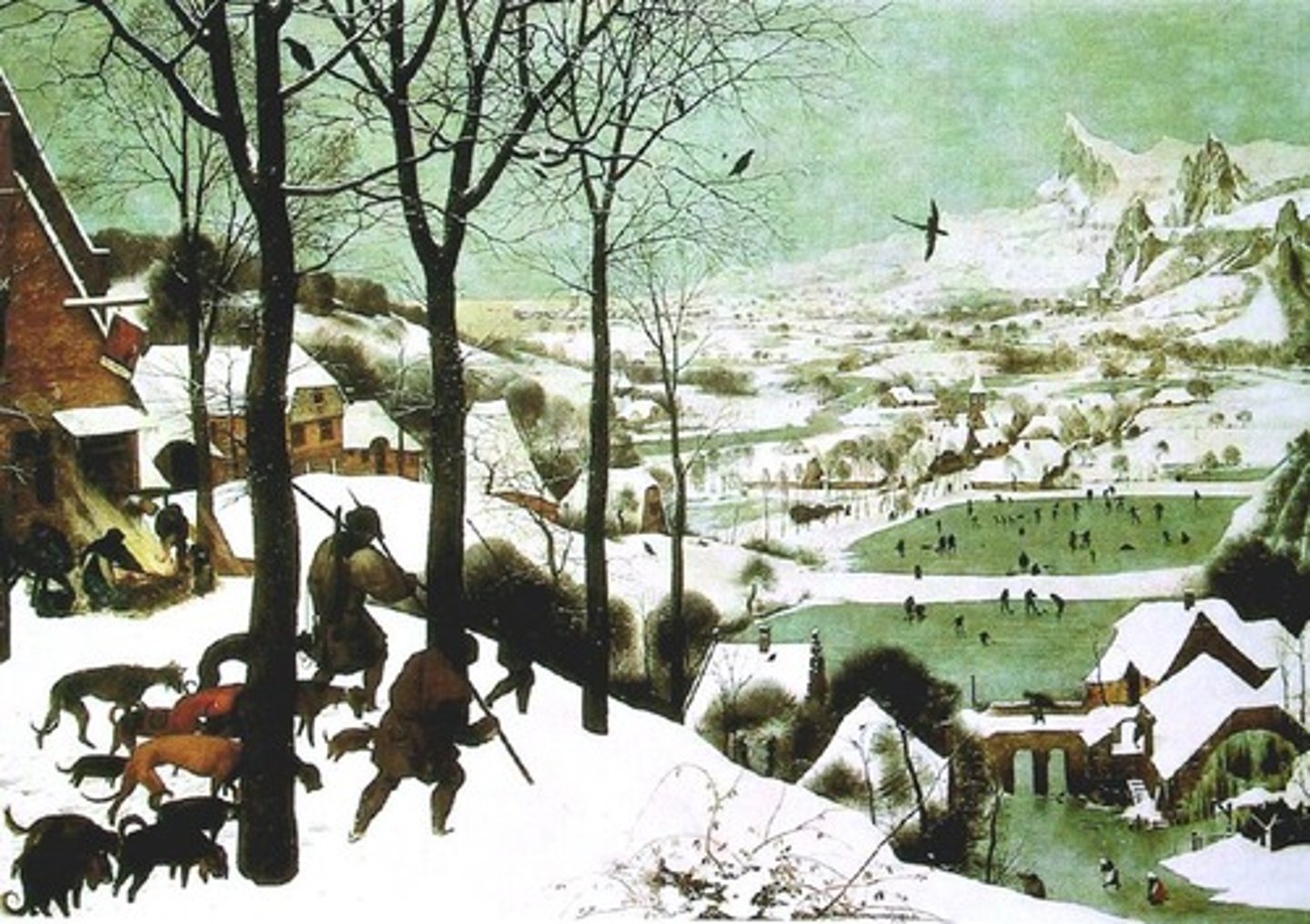
85. Calling of St. Matthew
Form:
-metaphysical painting
-Baroque (Counter Reformation, through your sense)
-diagonal light (tenebrism)
-realism/illusionism
-unusal setting for Jesus
Content:
-meant to be contemplated
-Jesus extended hand (same hand as in Sistine Chapel)
-Matthew sitting with fellow tax collectors
Function:
-body and soul are between a spiritual reality and physical reality
-Jesus shown in modern environment
-part of 3 part series
-use of light
-in chapel
Context:
-artist: Caravaggio; Rome, Italy
-1559-1600
-Contarelli Chapel

86. Henri IV Recieves Portrait of Marie de 'Medici
Form:
-oil on canvas
-floating figures
-part of a cycle
-shows an event in her life
-Catholic Baroque
Content:
-Henry IV present the picture of Marie that confirmed his religious identity; married a Catholic queen
-marries her so he can have a son and recreate him in a Catholic way
-Jupiter and Juno gives blessing to them
Function:
-"early harmony"
-part of a tribute to her life
-show that their marriage was official bc portrait
-shows political power, sophistication, and stability
Context:
-Peter Paul Rubens (Flemish painter)
-from Marie de' Medici cycle displayed in the Louvre
-1621-25 CE Flemish Baroque
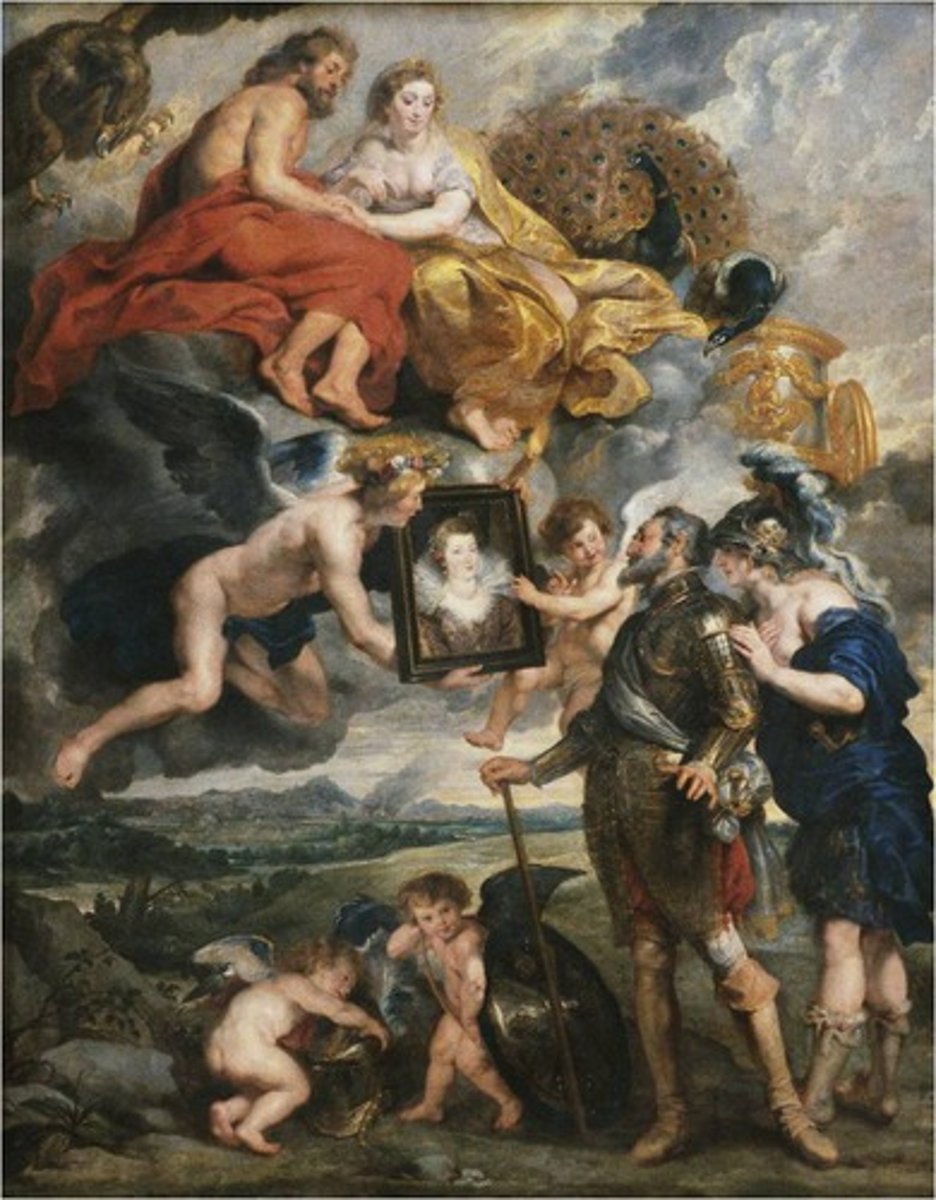
87. Self Portrait with Saskia
Form:
-Dutch Baroque
-difference in emphasis on the figures
-exists in 3 different states
-rich tonal quality
-abrupt spatial construction
-etching (exposing metal)
-genre: private movement between husband and wife
-small scale
Content:
-Rembrandt and wife in historical clothing
-wife, Saskia died at the age of 30 (only piece he did of her)
-Rembrandt drawing his drawing
-exploring who he is
Function:
-self portrait/marriage portrait
-role playing
Context:
-Rembrandt 1636
-he is mostly a portrait maker
-Dutch, Amsterdam
-Dutch Baroque
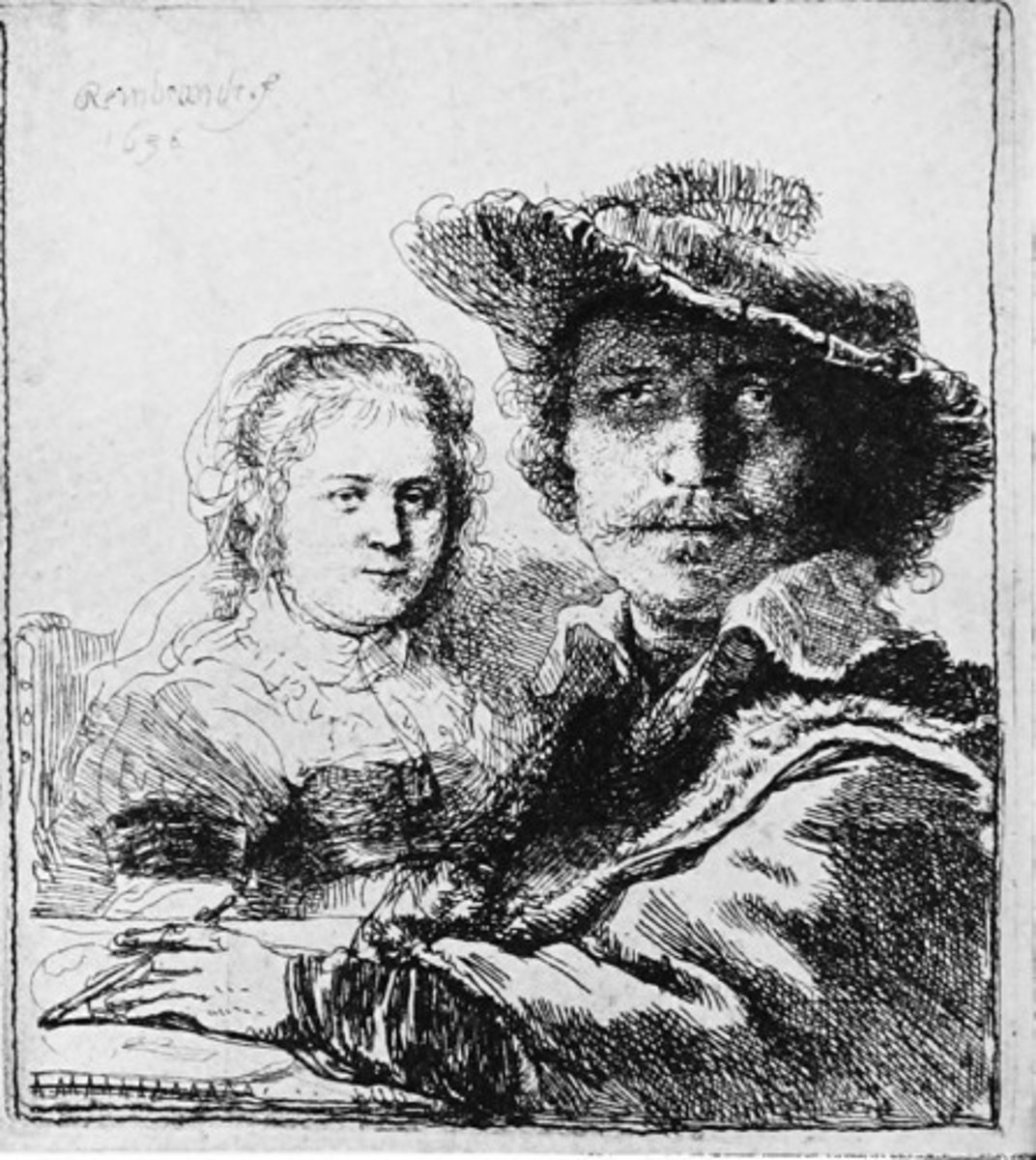
89. Ectasy of Saint Teresa
Form:
-marble, stucco, gilt bronze
-rich color
-many shapes and directions
-spiritual vs. physical
-Baroque
-shallow carving
-Counter-Reformation
Content:
-St. Teresa having a vision (physical and spiritual experience)
-fresco on ceiling
-Holy Spirit as a dove, light coming from HS
-columns serving as a frame as you enter chapel
-real daylight explosion
Function:
-Bernini's comeback after his scandal with mistress
-inspire and involve the viewer by bring sculptures to life
-after St. Teresa canonized
-shows union of world
Context:
-Rome; 1647-52
-artist: Bernini (very religious)
-sculpter, architect, painter
-Italian Baroque
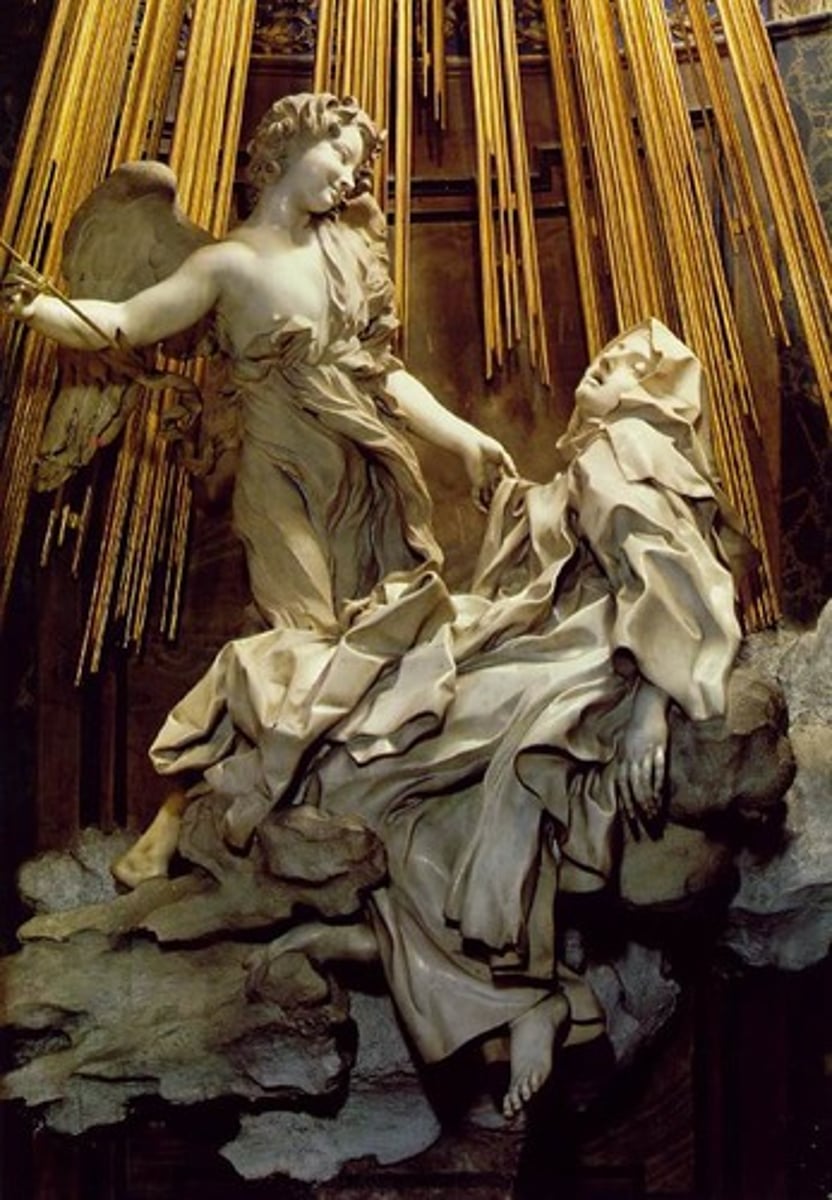
90. Angel with Aequebus
Form:
-Spanish Colonial Baroque
-idealistic
-Latin inscription
-oil paint
-part of a large history
Content:
-guns from 80 years war
-feathered crown
-nobility
-elegant clothing
-Catholic missionary
-Asiel fears God
-Church=army
-angel=soldiers
-aristocratic clothing
-Angel with gun
Function:
-militarist approach to faith
-propaganda for war
Context:
-17th century Peru
-artist: Asiel Timor Dei
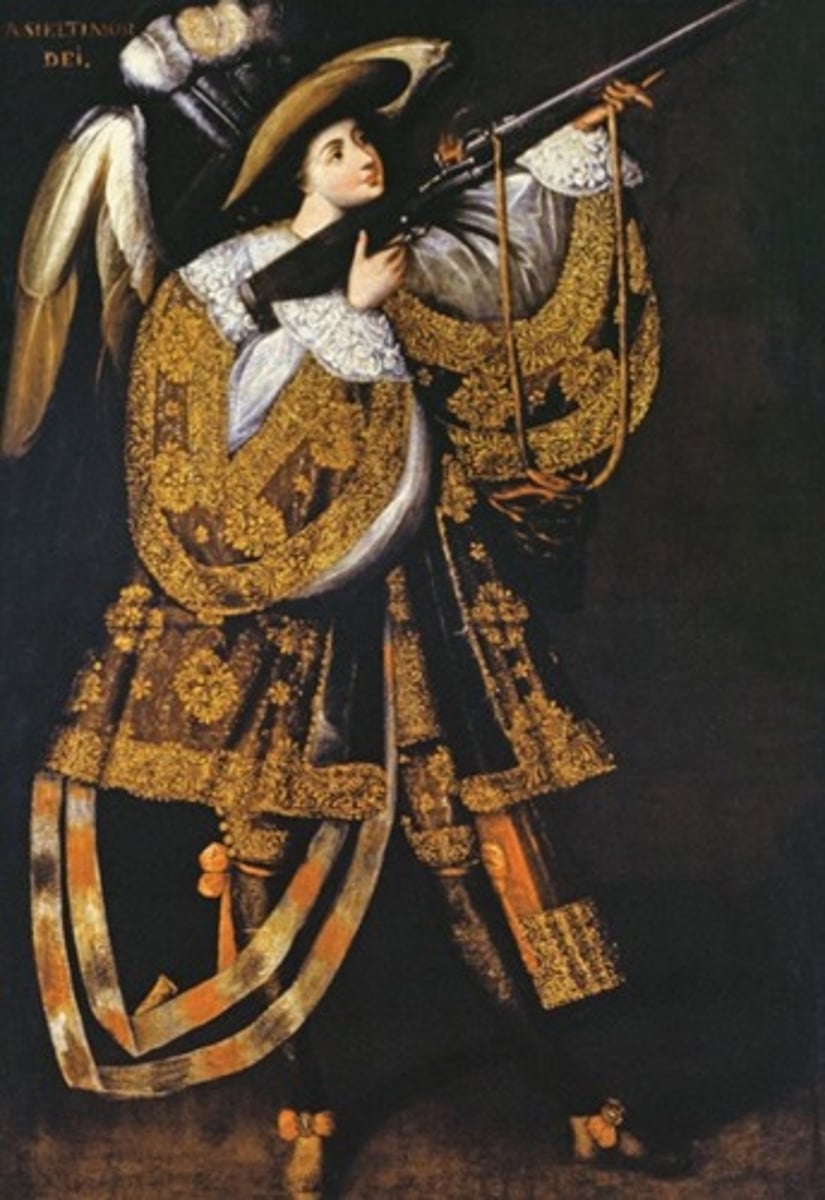
91. Las Meninas
Form:
-use of mirrors (Baroque)
-movement in strokes not as detailed as you think
-large painting
-gaze
Content:
-maids of honor and daughter
-dog=wealth
-self portrait of Velazquez
-painting in a painting
(Velasquez painting this painting
-people looking at viewer
Function:
-view of palace life
-show wealth/status
-made for Philip IV (the viewer)
-genre painting
Context:
-1656 CE; Prado, Madrid
-artist: Diego Velazquez
-Spanish Baroque
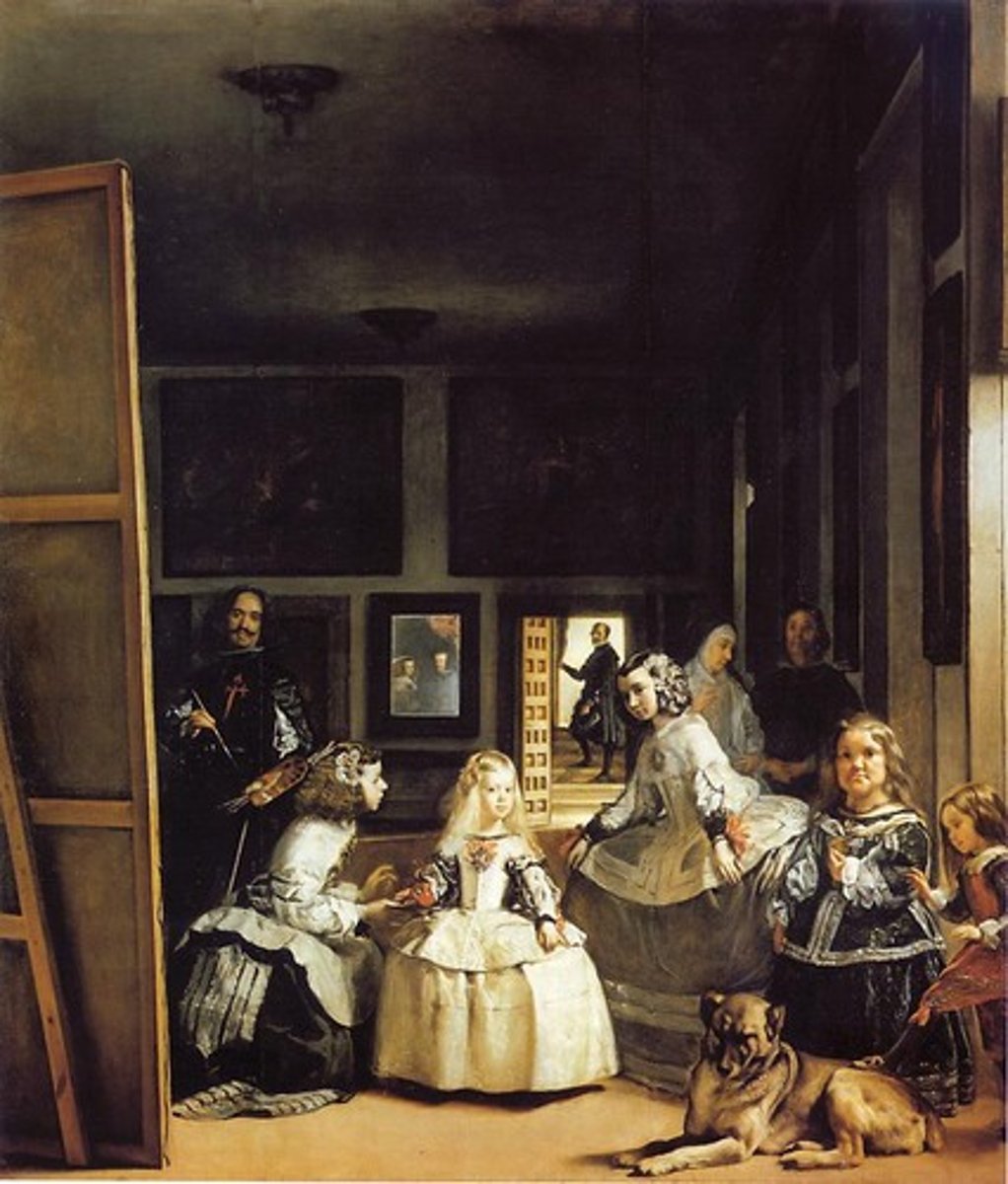
92. Woman Holding a Balance
Form:
-Catholic elements
-Scientific lighting
-genre scene
-small scale, oil on canvas
-use of light
-vanishing point
-color palette
Content:
-women part of upperclass (fine clothing)
-fur coat
-balance has nothing in it
-weighing valuables
-Last Judgement scene above
Function:
-material wealth
-painting for merchants
-religious meaning but not painted just for Church
-time and change
Context:
-artist: Johannes Vermeer
-1664 Dutch Baroque
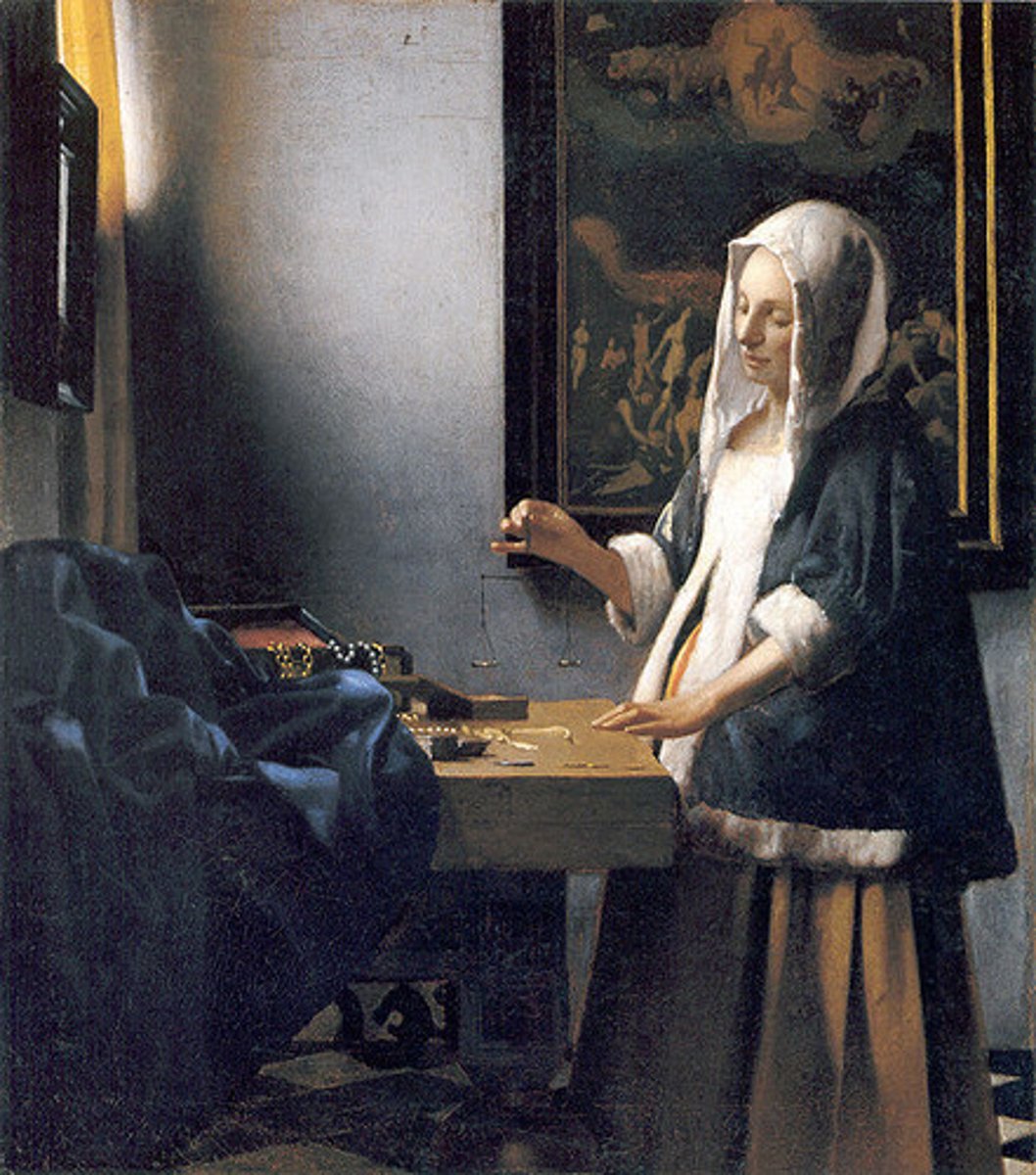
93. The Palace of Versailles
Form:
-east-west axis
-rigorous geometry
-classical architecture (symmetry, repetitive, and based on Greek temples)
-gold
-painted ceilings
-outside is not as "ornate"
-symmetrical
-Greek/Roman influence
-mirrors (hall of mirrors)
Content:
-Hall of mirrors (social gatherings)
-700 rooms
-gardens
-sculptures, paintings, fountains tributed to him
Function:
-King Louis XIV decided to build a new palace
-example of nobility
-living for King, his close friends, family, servants, and soldiers)
-emphasize Louis' importance (everything revolves around him
Context:
-Versailles, France
-Louis Le Vaw and Jules Hardouin-Mansart= architects
-began in 1669 CE, French Baroque

94. Screen with Seige of Belgrade and hunting scene
Form:
-Japanese folding screen (Biombo)
-Spanish Colonial Baroque
-tapestry
-tempora/resin on wood
-shell inlay (Aztec)
Content:
-historical event from Europe
-one side: battle scene
-other side: landscape
-Great Turkish War
-combines multiple cultures
Function:
-expresses exonomic power of the Spanish in Colonial Mexico
-made Spanish viceroy
-room divider (biombo- Japanese folding screen)
-relationship between Japan and Latin America
Context:
-Circle of Gonzalez Family, 1697-1701 CE
-Spanish Colonial
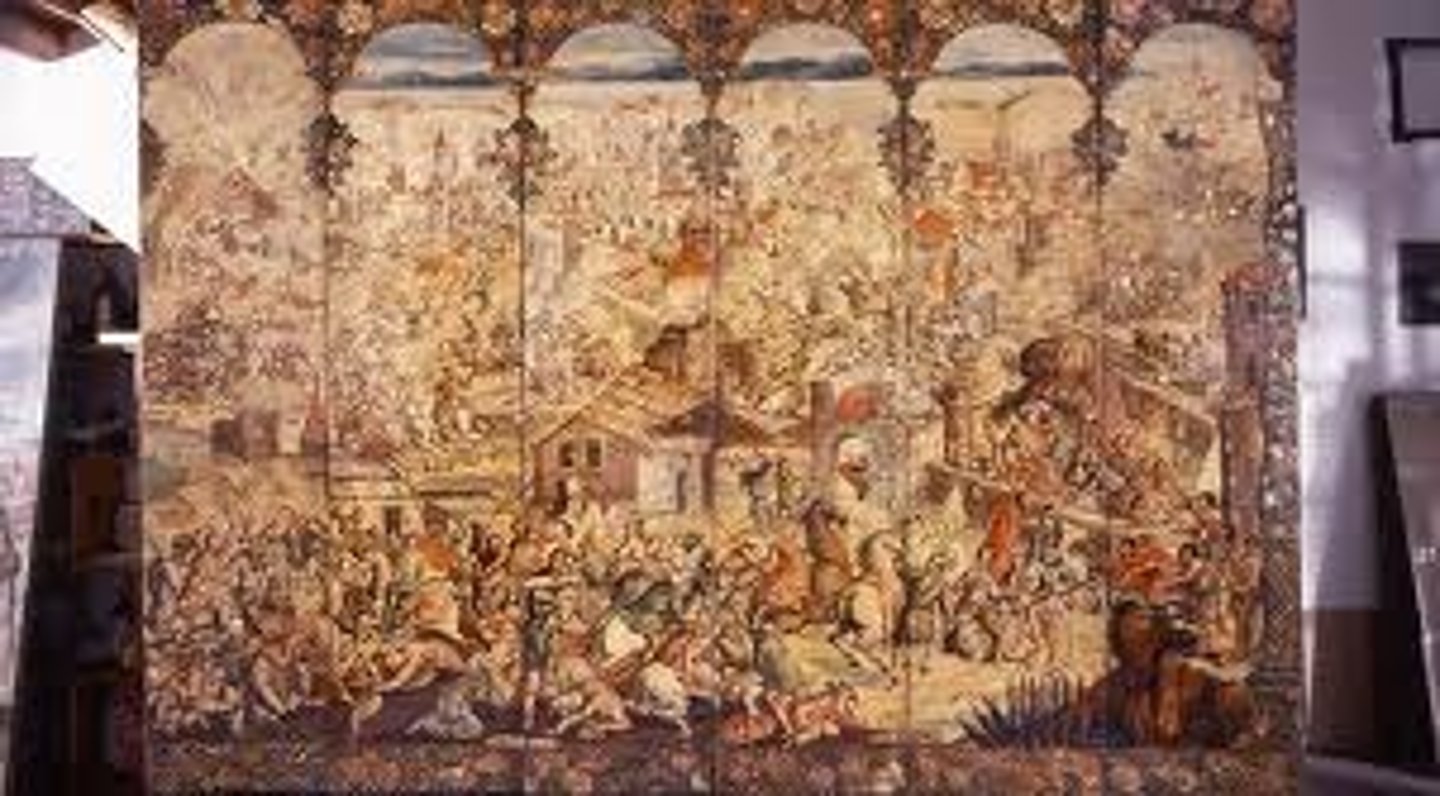
95. The Virgin of Guadalupe
Form:
-based upon the original
-oil on canvas on wood inlaid with pearls
Content:
-artist signature
-traditional view
-story of Juan Diego (Aztec man)
-roses with her image
-radiating light off Mary
-indigenous coming to Roman Catholic Church
-dark-skinned people portraits
FunctionL
-tribute to Mary and show her as divine
Context:
-1698 CE, Spanish Colonial
-Mexico City, Basiclia of Guadalupe
-artist: Miguel Gonzalez
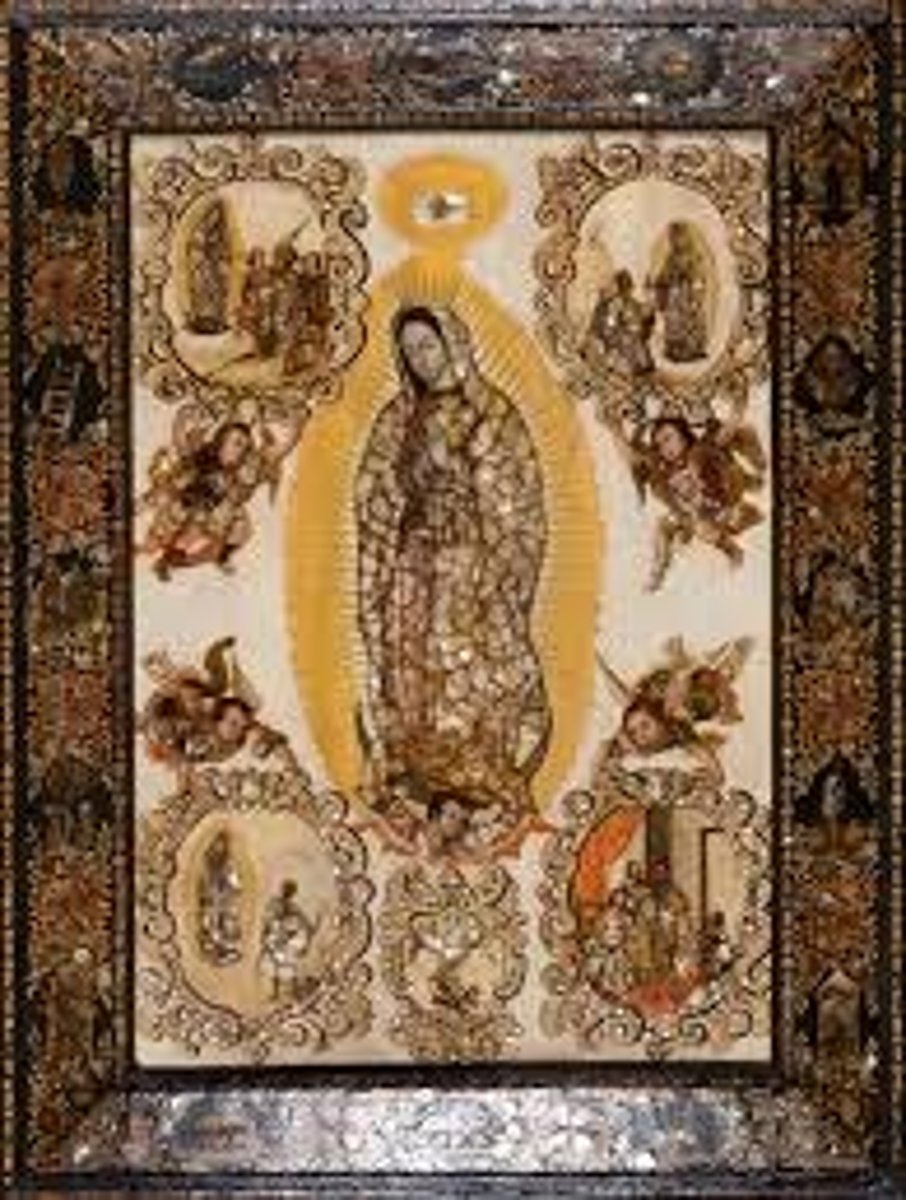
96. Fruit and Insects
Form:
-still life
-Baroque
-oil on wood
-colors, detailed
Content:
-insects, fruit
-wheat and grapes= Jesus?
-bringing different compositions together
Function:
-harvest in autumn
-microscopic organisms: used microscope to study these organisms
Context:
-artist: Rachel Ruysch (Dutch arist; last famous still painter)
-Florence, Italy 1711 CE (18th century)
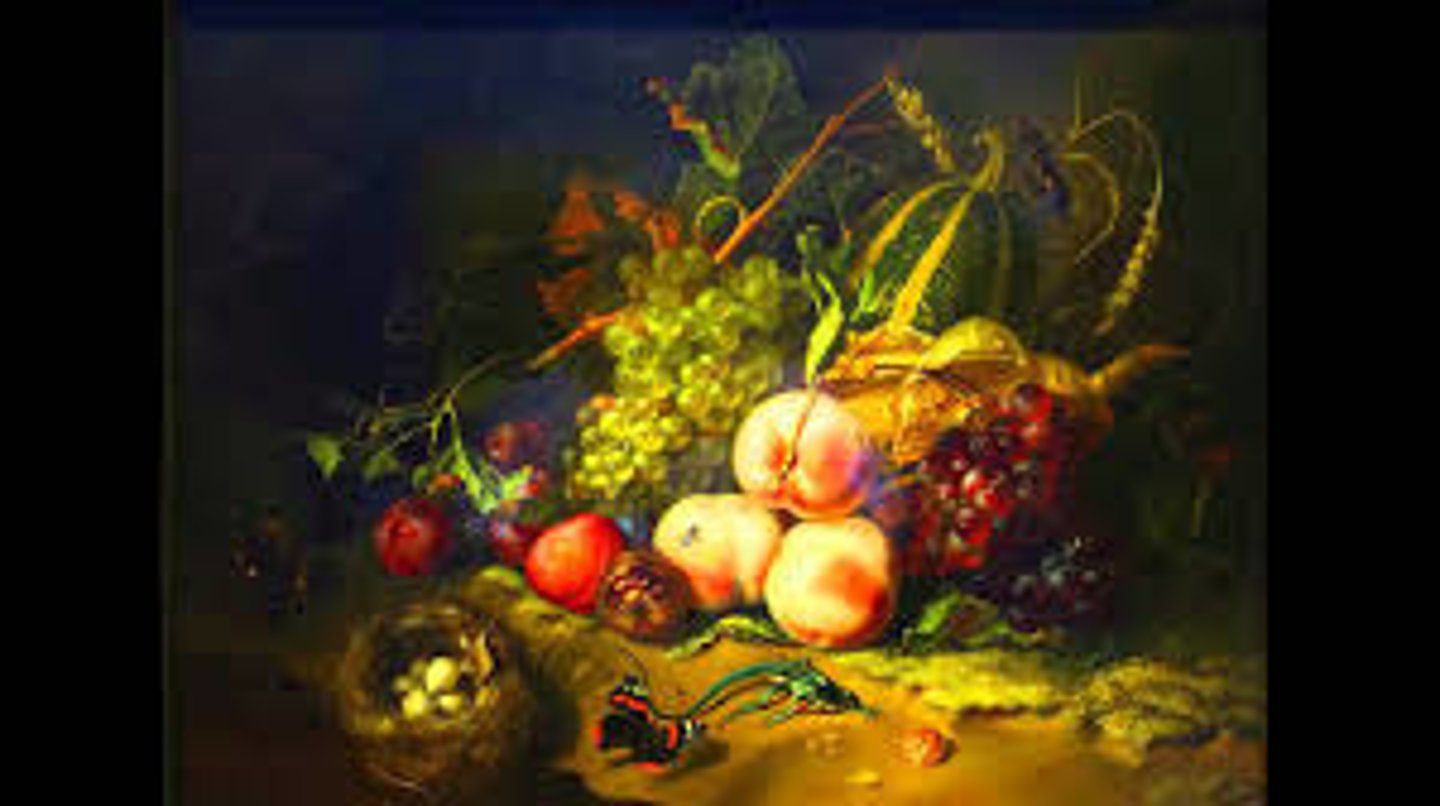
97. Spaniard and Indian Produce a Mestizo
Form:
-casta painting (displays mother, father, and child) possibly modeled after the Holy Family
-text is the title of the piece
-enlightenment
Content:
-woman wearing traditional Indian clothing and white father with their mixed race son (Father wearing French-style European clothing)
-servant carrying the son
-family appears content
-racial purity=whiteness
Function:
-displays social status (tied up in one's racial makeup)- helped maintain European power and control
Context:
-artist: Juan Rodriguez Juarez
-1715 CE (height of slave trade)

98. The Tete a Tete from Marriage a la Mock
Form:
-looks like French Rococo (uses to make fun of the French
Content:
-critques upper-class for getting married because of bloodlines and family
-shows the couple is married but not faithful to eachother
-man being sniffed by dog because smell of another woman's perfume
-woman has been out all night trying to become popular
-part of a series (arranged marriages end badly, marriage should be about love)
-sign that sex occurred before husband came back home (flipped over chair)
-merchant gives up on couple because they won't take finances seriously
Function:
-satire from British to French
-art being made for the growing middle class
Context:
-artist: William Hogarth (social critic)
-1743 CE

99. Portrait of Sor Juana Ines de la Cruz
Form:
- style: enlightenment
-baroque: billowing red curtain
-oil on canvas
Content:
-typical nun looks
-surrounded by books (educated)
-nun=sor
-wearing a shield
-has painting of Virgin Mary
-hold St. Jerome's translation of the Bible (her religious order is named after him)
-toys with rosary in her left hand
-gaze directly at viewer
-red curtains shows higher status
-woman taking on the clergy
Function:
-conveys religious and intellectual status
-feminist
Context:
-artist: Miguel Cabrera
-1750 CE
-location: Mexico City
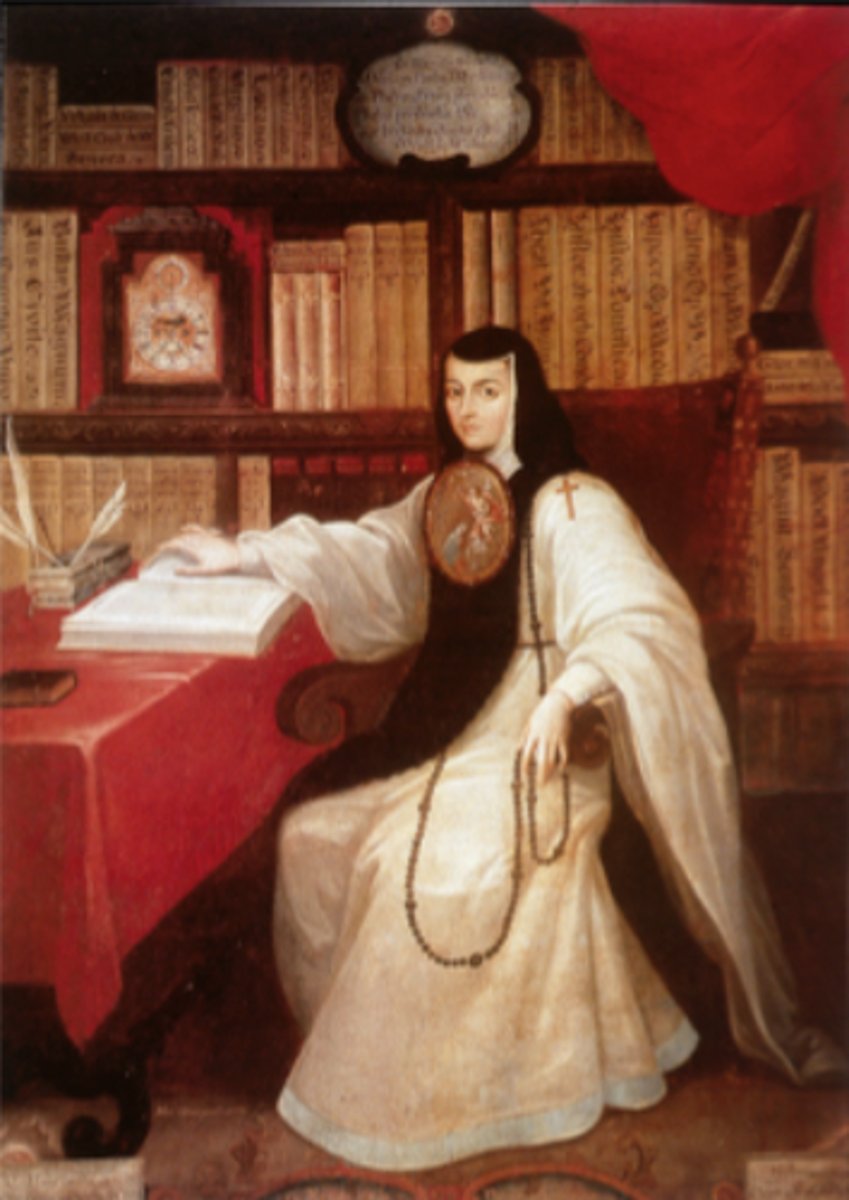
100. A Philosopher Giving a Lecture on the Orrery
Form:
-Tenebrism now used in secular aspects (mimicking Caravaggio)
-Chiaroscuro: contrast between light and dark
Content:
-orrery: model of the solar system (heliocentric)
-philosopher explain something to people in painting (education is sacred)
Function:
-introduction to science
-celebrates access to knowledge
-shift from religion to science
-philosophical groups emerging
Context:
-1763-1765 CE
-artist: Joseph Wright of Derby
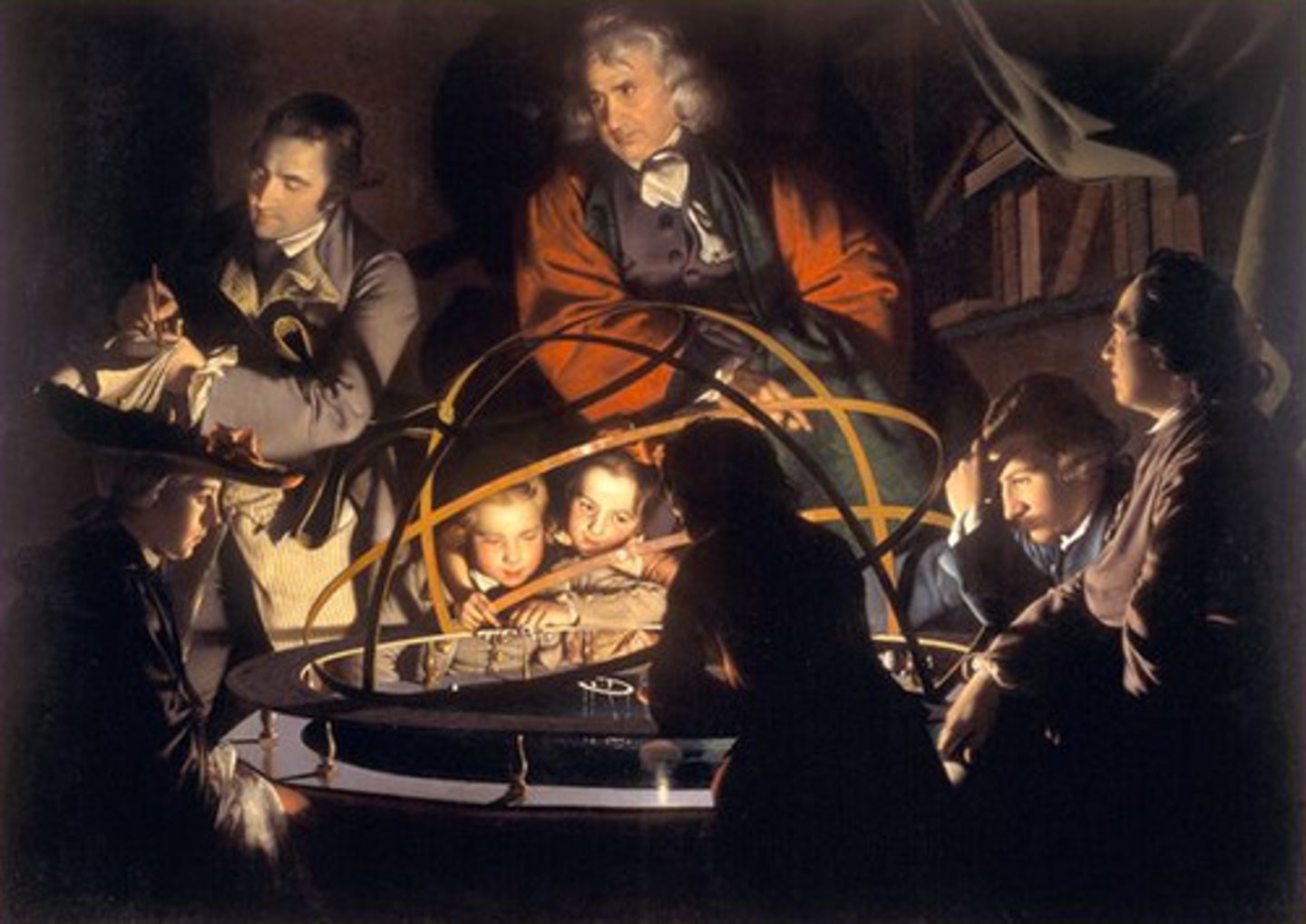
101. The Swing
Form:
-style: Rococo- love, pastels, aristocracy, arabesques, delicate paint application
-oil on canvas
Content:
-ideal love gardens with sculptures
-cupid whispering
-attendant swinging her=elite
-foot with expensive shoe
-French garden
-"peeping tom" in lower left
Function:
-made for aristocrats to decorate buildings
-show the pleasures and decadence enjoyed by the elite
Context:
-1767 CE (18th century)
-artist: Jean-Honore Fragonard
-Enlightenment

102. Monticello
Form:
-classical and enlightenment ideals (neoclassical) combining Italian Renaissance and French Classical architecture
-domestic
-symmetrical
-brick, glass, stone, wood
Content:
-expresses American virtue of a Republic through architecture
-two column deep extended portico that support triangular pediment decorated by a semicircular window (doric columns)
-shallow dome
Function:
-plantation house for Jefferson
Context:
-Virginia, USA 1768-1809
-Romanticism/Classicism on the rise
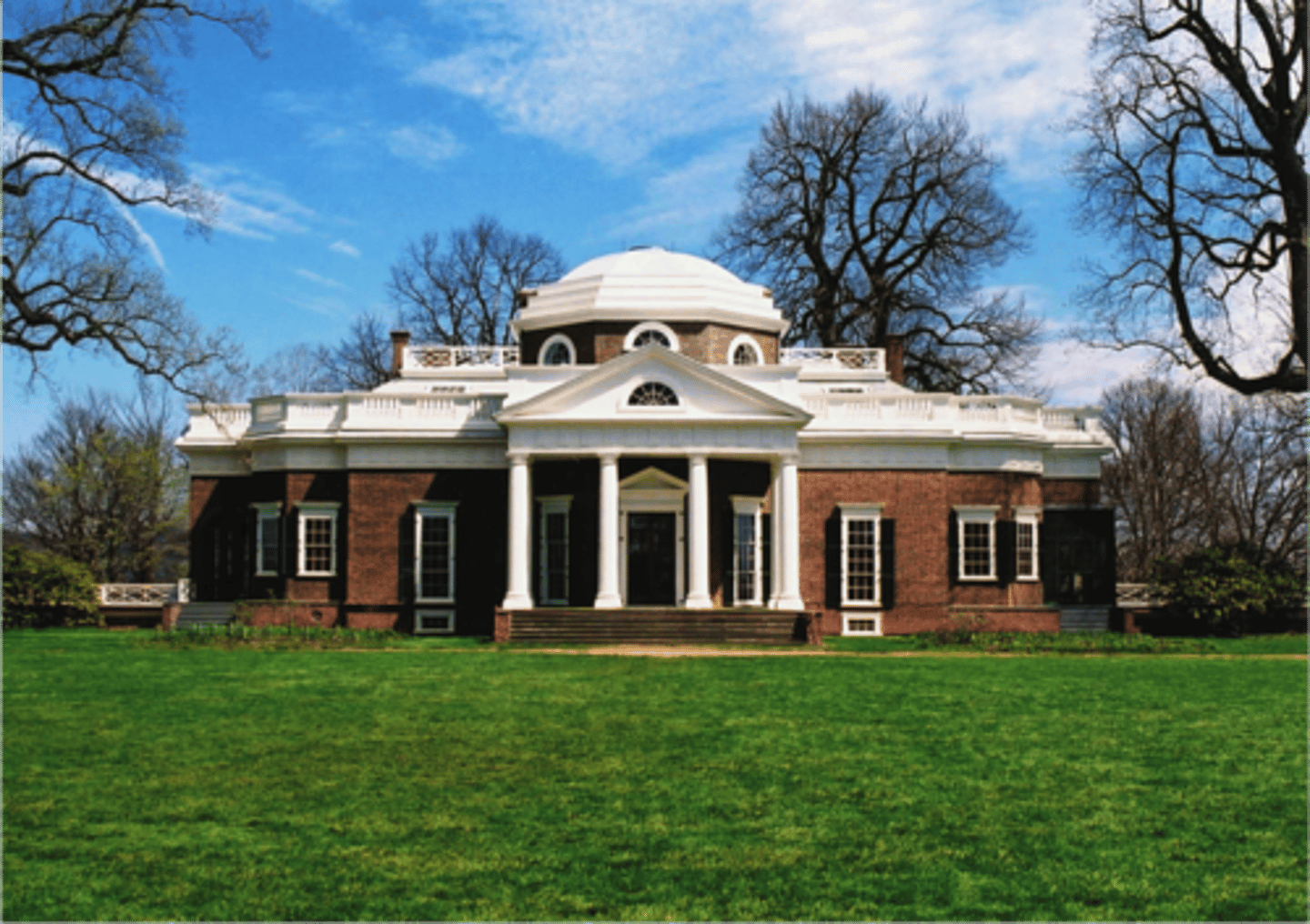
103. The Oath of the Horatii
Form:
-neoclassical (physicality and intense emotions)
-dramatic, rhetorical gestures
-geometric forms with the contrasting curvy formed women
-single light shined upon them at the heightened drama of the scene
Content:
-"what are you willing to die for?"
-3 brothers saluting towards the swords which are held by their father (take oath to defend Rome)
-woman grieving in back ground because they have to deal with consequences of war (either lose husband or their bro)
-sacrifice oneself for good
Function:
-challenge aristocracy
Context:
-Jacques-Louis David 1784 (before the revolution)
-commissioned by King of France
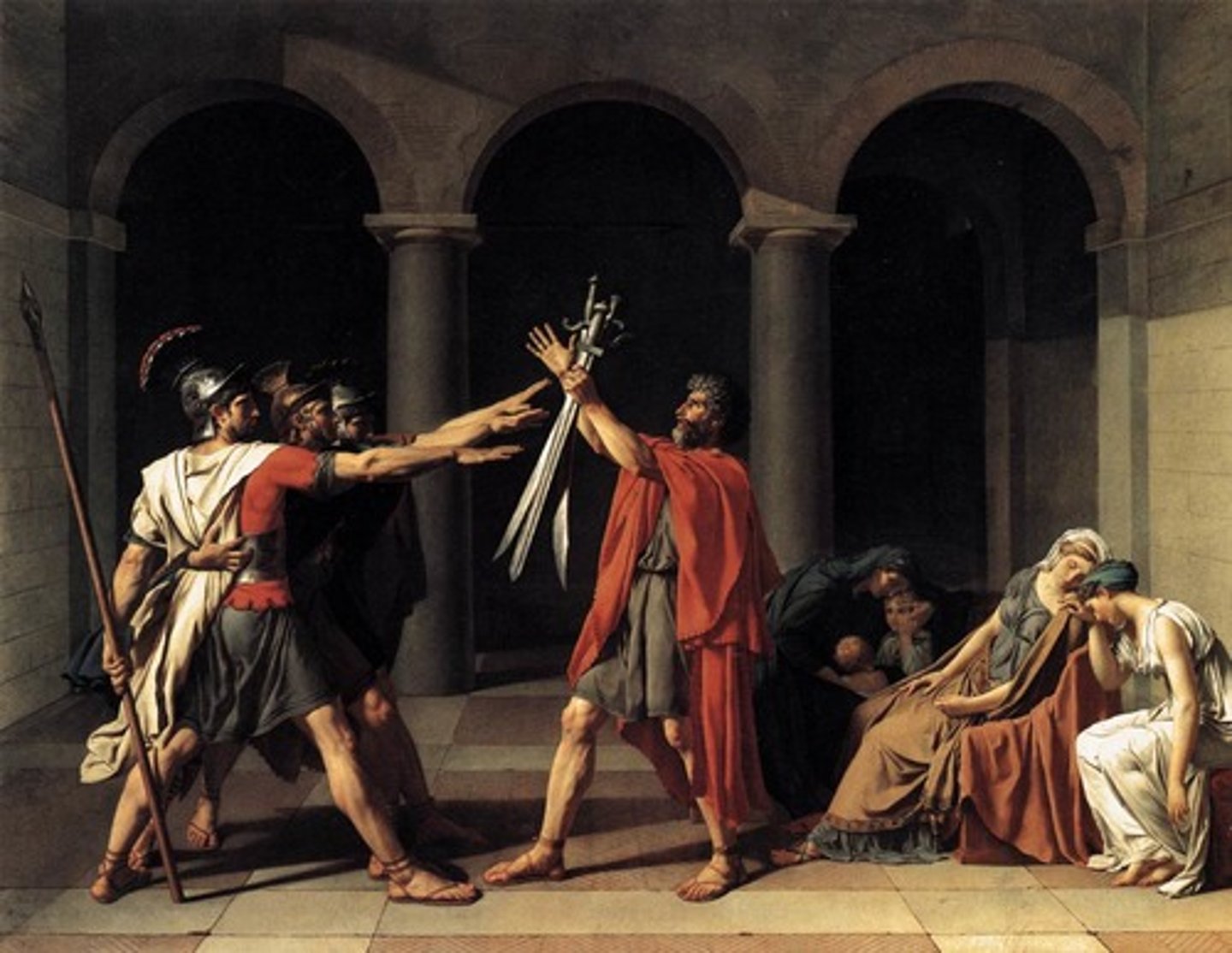
104. George Washington
Form:
-contrapposto
-neoclassicism (influenced by essence of Greek art as opposed to Rococo)
-realistic
-idealistic
Content:
-captured the duality of Washington (private citizen and public soldier)
-bundle of 13 rods (symbolizes not only power but strength found through unity
Function:
-commemorate momentous occasion after the revolutionary war
Context:
-artist: Jean-Antoine Houdon (commissioned by Jefferson)
-1788-92 CE made by foreigner
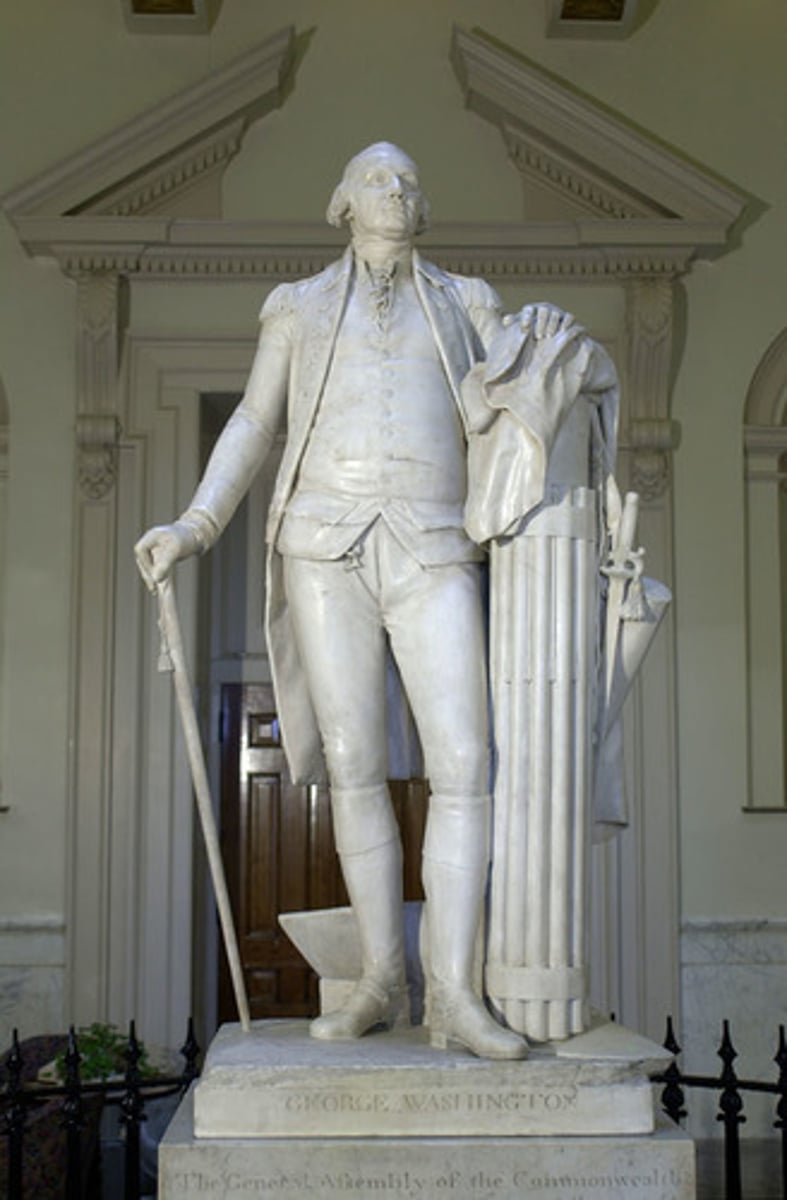
105. Self Portrait
Form:
-oil on canvas
-portrait
-light brushwork and colors (Rococo style)
-Enlightenment
Content:
-shows her in process of creating the self portrait of Marie Antoinette (she was her court painter)
-holding palette and paint brush (showing she is skilled)
-interrupts her but she welcomes the interruption
Function:
-shows that she is a painter
-several different version
Context:
-artist: Elizabeth Louise Vigee Le Brun
-1790 CE, Rococo-Neoclassicism (in between)
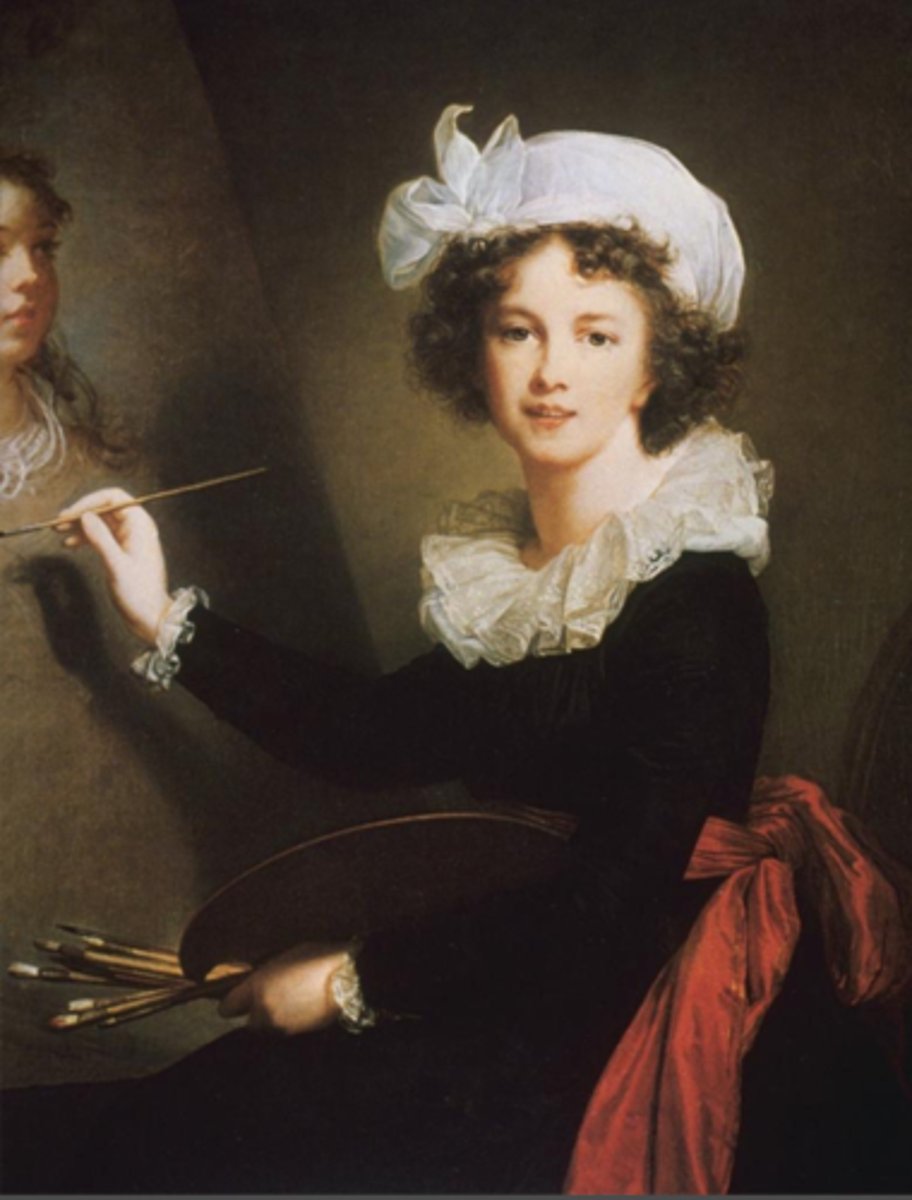
106. Y no hai remedio (And There's Nothing To Be Done)
Form:
-style: romanticism (challenging power and oppression)
-etching, drypoint
Content:
-part of series of 82 called Disasters of War
-what human beings capable of
-government misuse of power on helpless victims
-man is blindfolded with head down tied to wooden pole (christ-like)
-recently deceased corpse with extreme detail of his grotesque face (behind body on pole is a dead body on pole)
Function:
-pictures the atrocities of war
-visual indictment and protest against French occupation of Spain
Context:
-publish 1863, made 1810-1823 CE
-artist: Francisco Goya (trained by Rococo)
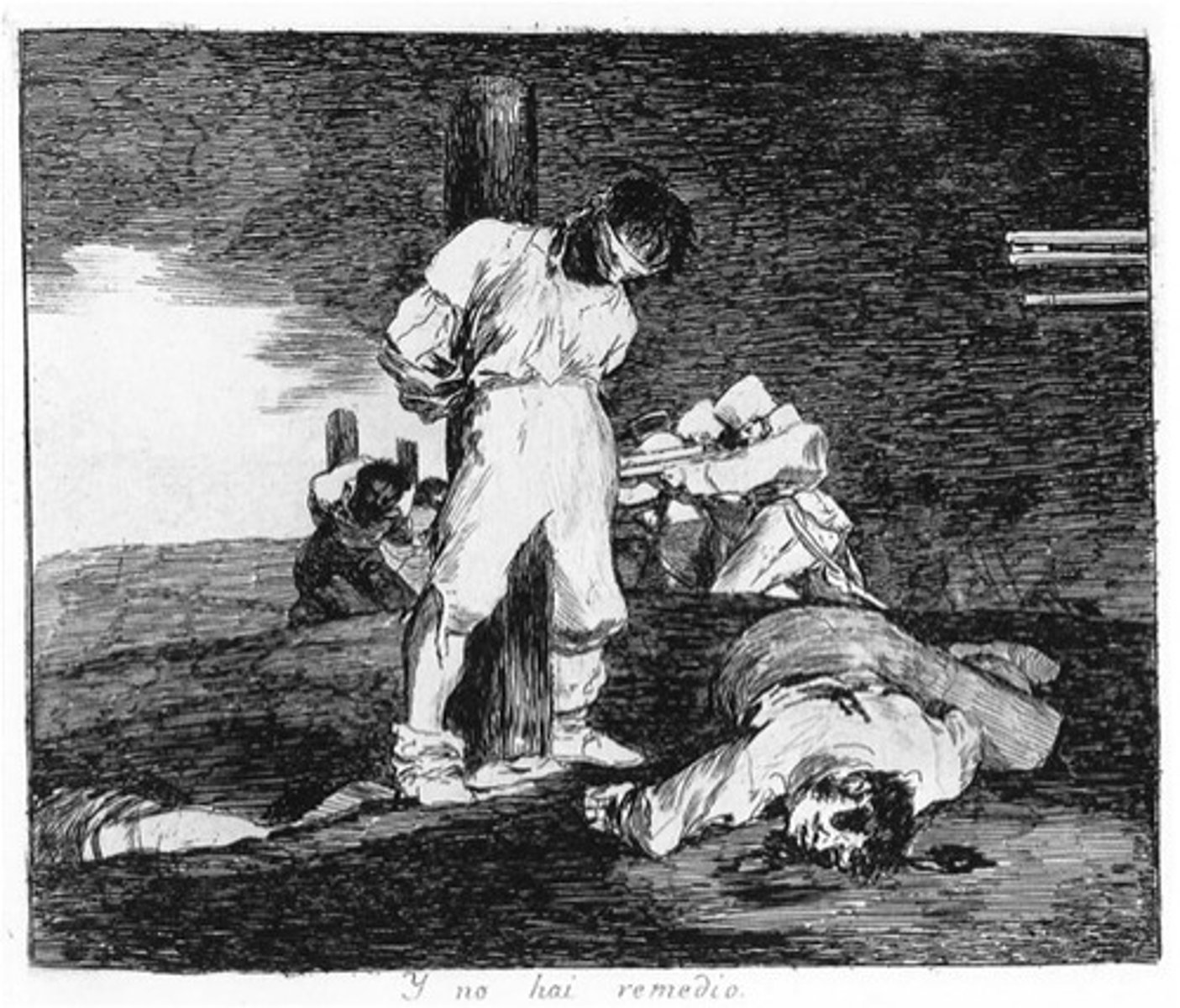
107. La Grande Odalisque
Form:
-romanticism (exoticism)
-classical figure
-proportions are messed up
-oil on canvas
Content:
-physically unreal body
-peacock fan, turban, enormous pearls, hookah (eroticism based on exotic content)
Function:
-what a French male's fantasy would look like
Context:
-artist: Jean-Auguste-Dominque Ingres (court painter for Napoleon
-1814 CE
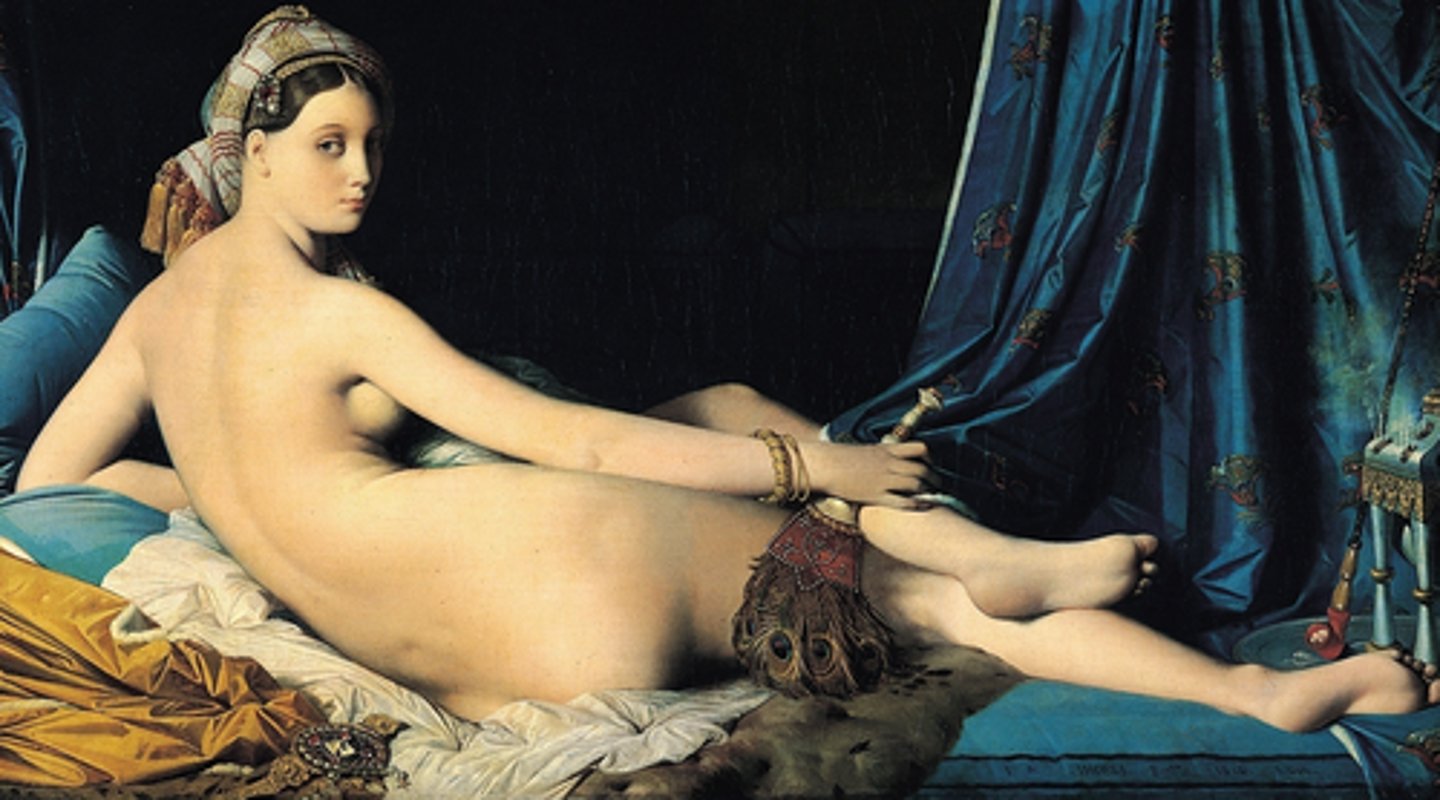
108. Liberty Leading the People
Form:
-romanticism
-seems as though it is overpowered by chaos but filled with subtle order
-oil on canvas
Content:
-people of both the working class and middle class join in the fight against the government
-lady carrying the French flag meant to serve as an allegory, in this case a moral or political idea of Liberty (looking back to make sure people are following, represents an idea)
-background: Notre Dame
Function:
-allow us to believe anyone can be a revolutionary
Context:
-artist: Eugen Delacroix
-1830 CE
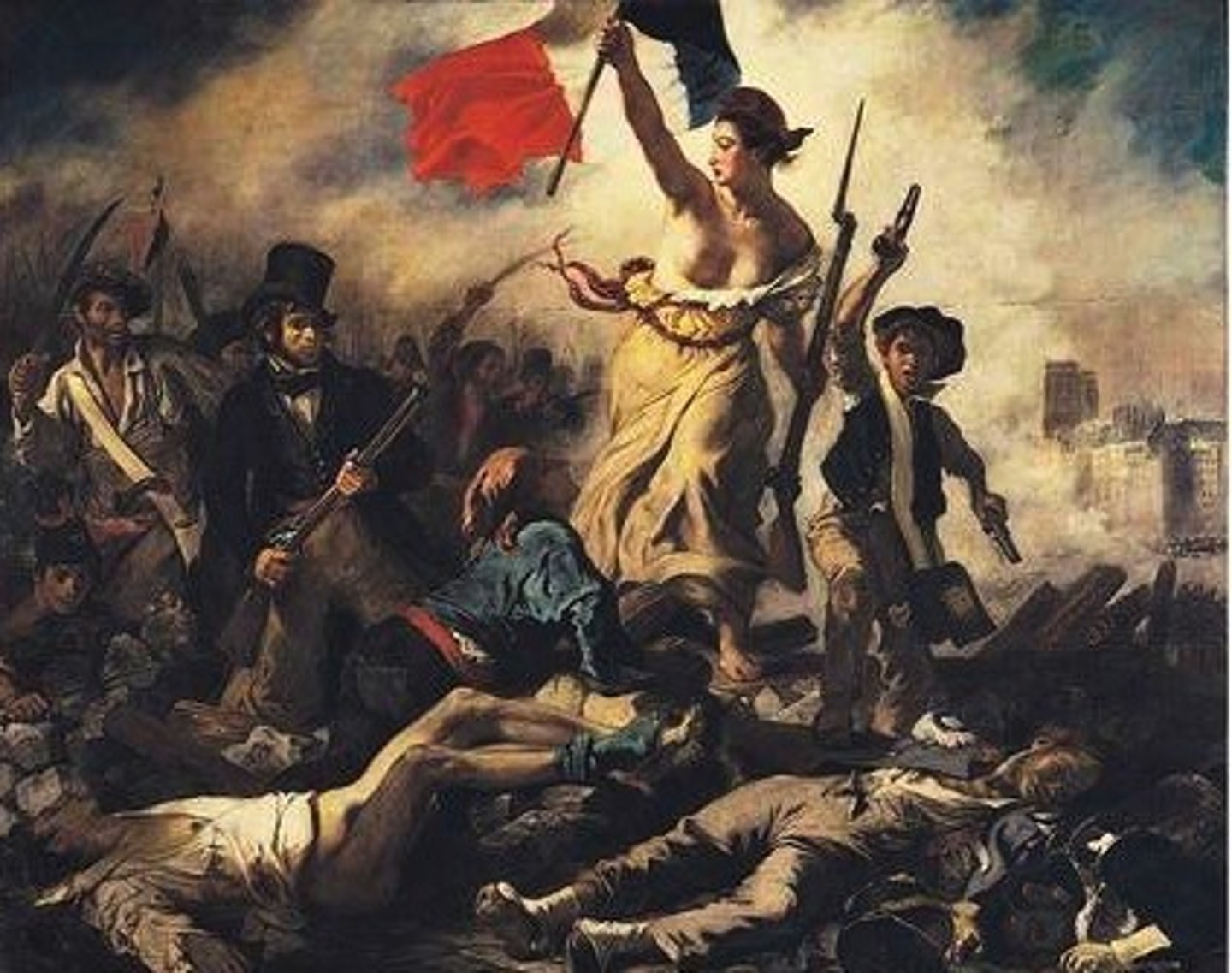
109. The Oxbow
Form:
-romanticism
-Manifest Destiny
-not based of a real place
-oil on canvas
Content:
-reverence for nature
-filled with life
-based on real life area
-divides the painting into two unequal sections
-one shows sublime view of land untouched by man (wild, untamed)
-other side shows land humankind has taken over (overtaken by agriculture)
-self portrait of himself wandering
Function:
-landscape painting
-shows respect for nature
Context:
-Northampton, Massachusetts
-artist: Thomas Cole (leader of Hudson River School)
-1836 CE (19th century)
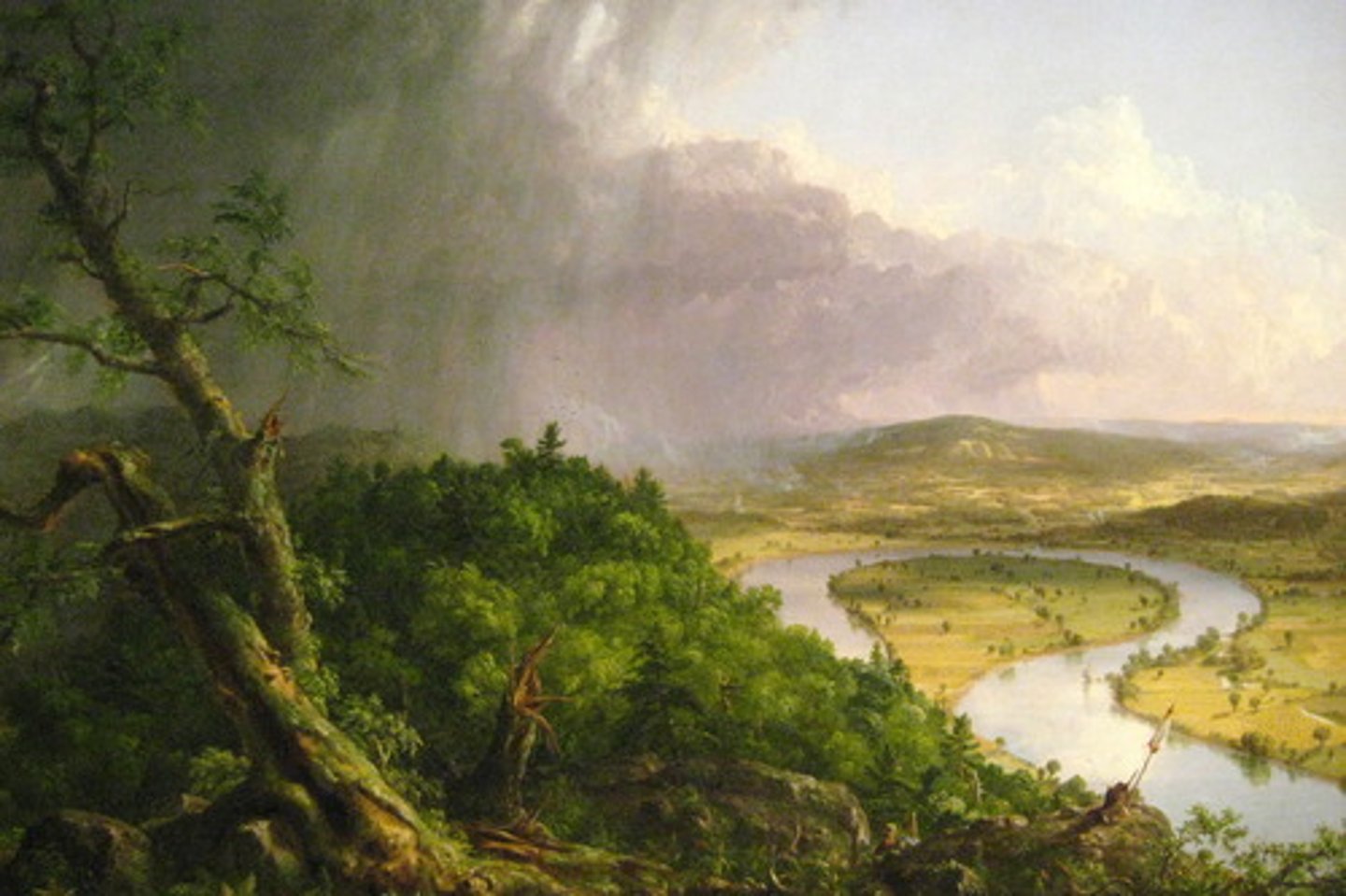
111. Slave Ship
Form:
-romanticism (sublime)
-combines a beautiful and horrible scene together
-rich colors
-loose brushwork
-oil on canvas
Content:
-beautiful seascape looking at first but if u look close you see slaves drowning and being eaten alive
-disease breaks out on ship and overthrows all the dead and sick overboard so they can get insurance (money is motivator for what they did)
Function:
-political and social activist piece
Context:
-artist: Joseph Mallord William Turner
-1840 CE
-inspired by a book
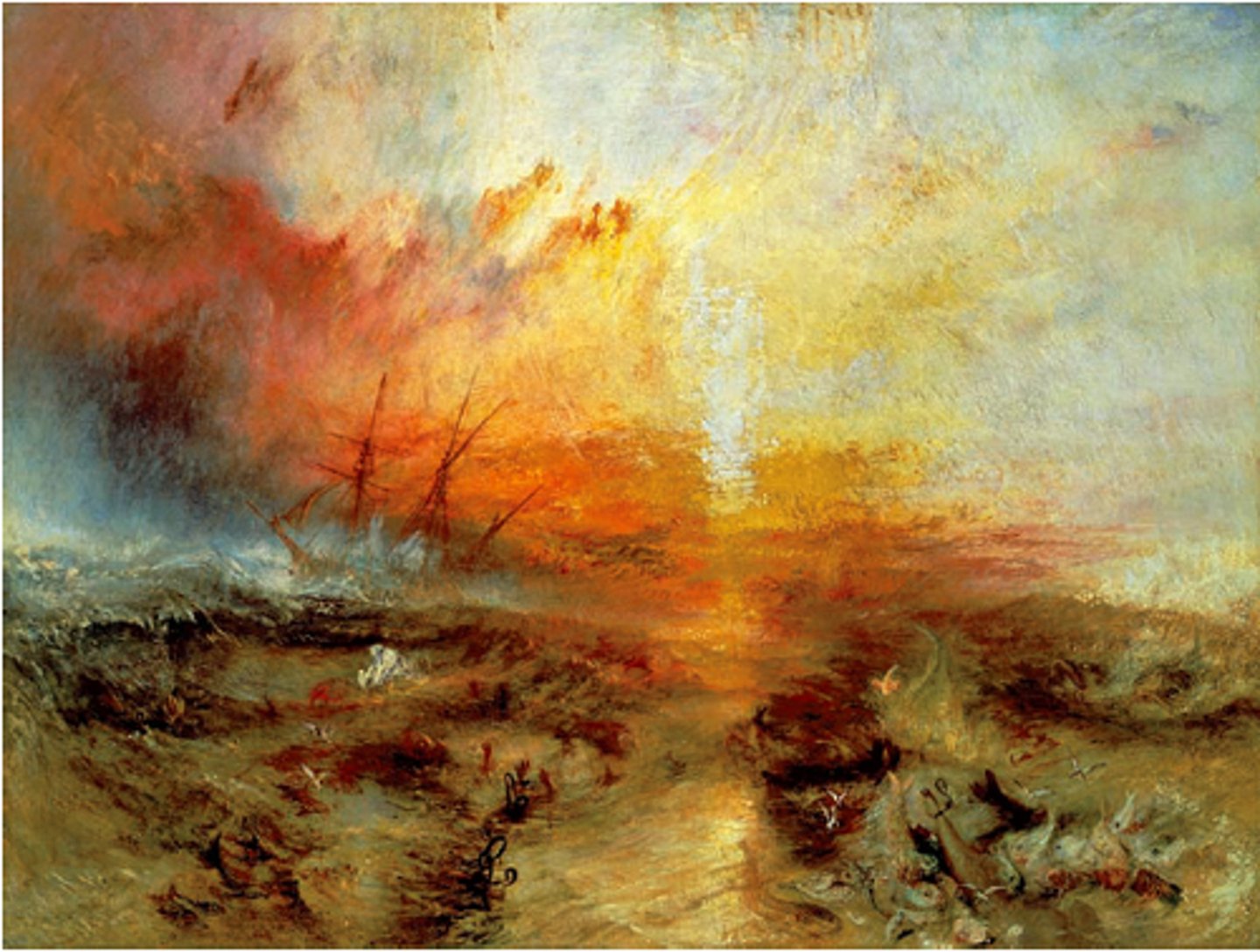
112. Palace of Westminster
Form:
-Hammer Beam Construction in the Westiminster Hall
-Romanticism
-classical building with a Gothic exterior, Gothic revival
-limestone, masonry, glass
Content:
-central lobby
-westiminster hall (oldest section)
Function:
-where the House of Lords and Commons meet
-rebuilt because a fire burned down old palace that was originally there
Context:
-London, England
-architect: Charles Barry
-designer: Augustus Pugin
-1840-70 CE
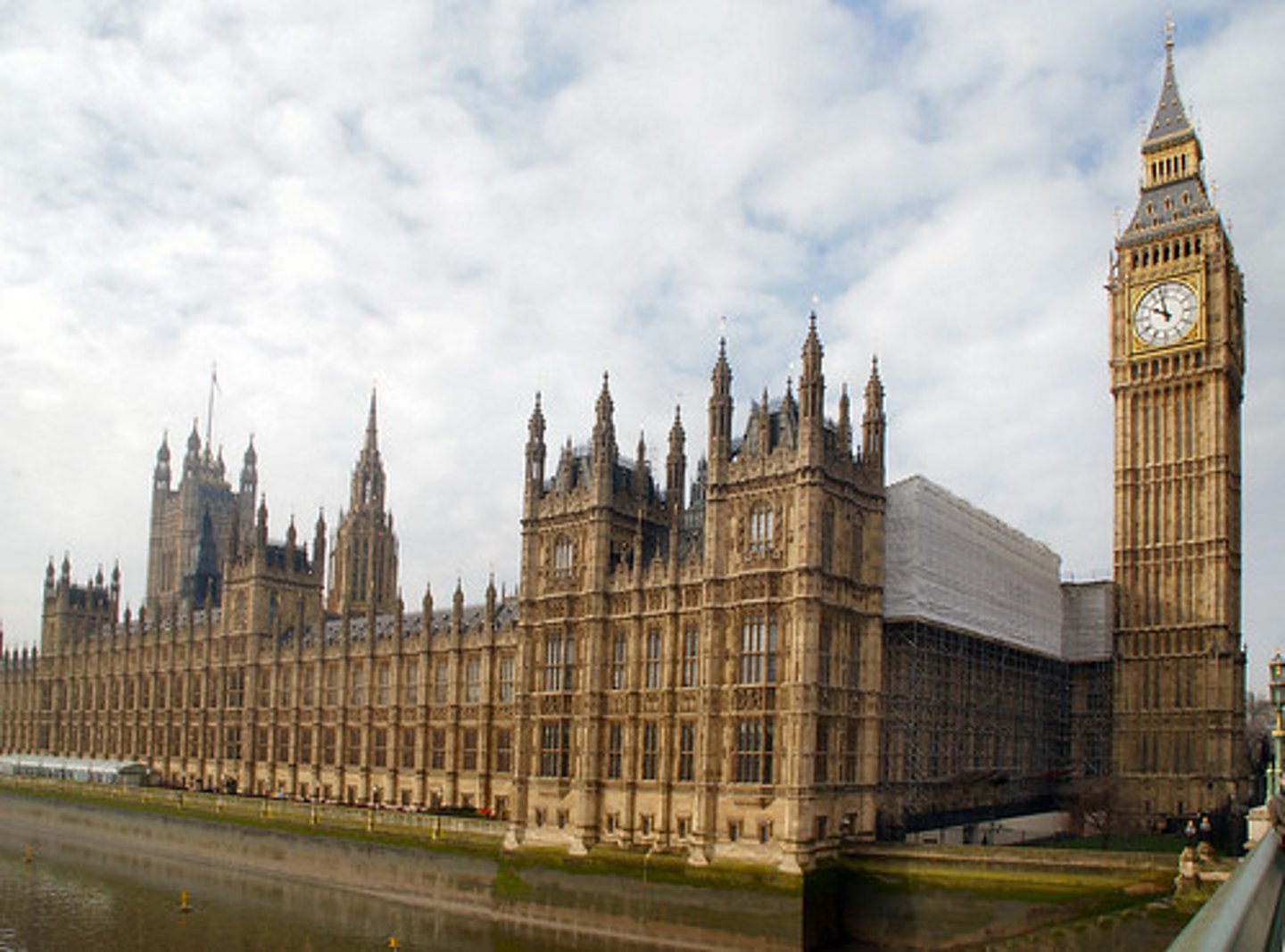
121. The Coiffure
Form:
-impressionism
-overall curves and crisp line
-drypoint/aquatint
-genre scene
-etching
Content:
-her prints are accessible and they can own them
-influenced by Japanese Wood Block Prints (ukiyo-e)
-preparing one's hair refers to ideals of femininity and beauty
Function:
-gives image of glamorous woman in glam setting
-Japanese influence
-capture fugitive, fleeting moment of the busy lives of the working class
Context:
-America w/ Japan twist
-1890-91 CE
-artist: Mary Cassat
